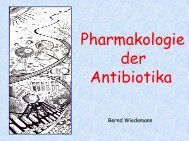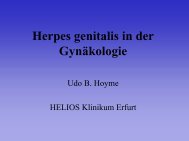H. pylori Atrophische Gastritis
H. pylori Atrophische Gastritis
H. pylori Atrophische Gastritis
Erfolgreiche ePaper selbst erstellen
Machen Sie aus Ihren PDF Publikationen ein blätterbares Flipbook mit unserer einzigartigen Google optimierten e-Paper Software.
Gastrointestinale Erreger – ein Update<br />
Helicobacter <strong>pylori</strong><br />
A. M. Hirschl<br />
Klinische Abteilung für Klinische Mikrobiologie<br />
Klinisches Institut für Hygiene und<br />
Medizinische Mikrobiologie<br />
Medizinische Universität Wien
Verlauf der H. <strong>pylori</strong> Infektion<br />
Akute <strong>Gastritis</strong><br />
Chronische <strong>Gastritis</strong><br />
• Bakterielle Faktoren<br />
• Wirtsfaktoren<br />
Antrum prädominant<br />
Multifokale Atrophie<br />
Ulcus duodeni<br />
(Alter 20-40)<br />
Ulcus ventriculi<br />
(Alter 40-70)<br />
Magen Karzinom<br />
(Alter > 70)
H. <strong>pylori</strong> –Assoziation mit<br />
gastrointestinalen Erkrankungen<br />
• Bis zu 50% der Infizierten → <strong>Atrophische</strong> <strong>Gastritis</strong><br />
• Bis zu 10% der Infizierten → Peptisches Ulkus<br />
• 1-2% der Infizierten → Magenkarzinom<br />
Kuipers, ATP 1999
H. <strong>pylori</strong> und Magensäure<br />
ECL-Zellen<br />
Histamin<br />
+<br />
G-Zellen (Antrum)<br />
Gastrin<br />
+<br />
Vagus<br />
Acetylcholin<br />
-<br />
Parietal-<br />
Zellen<br />
Magensäure<br />
+<br />
-<br />
Magen pH ↓<br />
D-Zellen (Antrum)<br />
Somatostatin
3 Phänotypen der H. <strong>pylori</strong>-Infektion<br />
• Milde Pangastritis ohne wesentliche Störung der<br />
Magenphysiologie und ohne signifikante<br />
Erkrankung<br />
• Magenkarzinomtyp: Corpus dominante <strong>Gastritis</strong><br />
mit Atrophie und Hypochlorhydrie<br />
• Ulcus duodeni-Typ: Antrum dominante <strong>Gastritis</strong><br />
mit Hyperchlorhydrie
Bakterielle Faktoren (Beispiele)<br />
• Cag-Pathogenitätsinsel<br />
• Vakuolisierendes Zytotoxin (Vac A)<br />
• Säureresistenz (Urease)<br />
• Adhäsion und äußere Membranproteine<br />
–Bab A<br />
–OipA<br />
–SabA<br />
– Ice A<br />
• Lipopolysaccharid
Kusters et al, Clin Microbiol Rev 2006<br />
Cag-Pathogenitätsinsel
Wirt-spezifische Faktoren (Beispiele)<br />
• Immunantwort<br />
• Genpolymorphismen<br />
– IL-1 Gencluster<br />
–IL-8<br />
–IL-10<br />
–TNF-α
Assoziation von DU mit der Anzahl regulatorischer<br />
T-Zellen in der Magenschleimhaut<br />
Robinson et al, Gut 2008
El Omar et al, Nature 2000<br />
Interleukinpolymorphismen und<br />
Magenkarzinom
Etablierte Indikationen zur Diagnose und<br />
Therapie der H. <strong>pylori</strong> Infektion<br />
• Aktive Ulkuskrankheit (DU, GU)<br />
• Anamnese eines DU od. GU ohne bisherige<br />
Eradikationstherapie<br />
• Dyspeptische Beschwerden<br />
• MALT-Lymphom des Magens<br />
Maastricht II-2001<br />
Maastricht III-2005<br />
Am Coll of Gastroenterol Guidelines 2007
Ford et al, Cochran Review 2003
Häufigkeit der Ulkusblutung nach erfolgter<br />
Eradikationstherapie<br />
Anzahl<br />
Studien<br />
Anzahl<br />
Patienten<br />
Blutung<br />
(%)<br />
Follow up<br />
Patienten-Jahre<br />
Blutung<br />
jährlich %<br />
30 1650 21 (1,3%) 2886 0,8<br />
Gisbert et al, Helicobacter 2007
H. <strong>pylori</strong> und dyspeptische Beschwerden<br />
• 10% relative Risikoreduktion (95%CI 6-14%)<br />
beim Eradikationstherapie vs. Placebo<br />
• NNT = 14<br />
• „test and treat“ Strategie in Konsensus-<br />
Konferenzen empfohlen<br />
• Zusätzlicher Nutzen: PUD↓, GC↓
Cochrane Meta-Analyse randomisierter kontrollierter<br />
Studien zur H.<strong>pylori</strong>-Eradikation bei Patienten<br />
mit Dyspepsie<br />
Moayyedi P et al, Cochran Review 2006
Patient mit Dyspepsie<br />
< 45 Jahre<br />
keine<br />
Alarmsymptome<br />
≥ 45 Jahre<br />
Alarmsymptome<br />
HP-Prävalenz<br />
≤ 20%<br />
HP-Prävalenz<br />
> 20%<br />
PPI<br />
„test and<br />
treat“<br />
„test and<br />
treat“<br />
Versagen<br />
Versagen<br />
PPI<br />
Endoskopie
H. <strong>pylori</strong> und MALT Lymphom<br />
• Niedrig malignes MALT Lymphom<br />
– Inzidenz: 1/100000<br />
– 92-98% H. <strong>pylori</strong> assoziiert<br />
– Heilungsrate 50-100% (E I 1 >E I 2 >EII)<br />
– Kumulative Rezidivrate: 12% nach 3 Jahren<br />
• Hoch malignes MALT Lymphom<br />
– Komplette Remission in 64%<br />
– Rückfallrate 0%
Kontroversielle Indikationen zur Diagnose<br />
und Therapie der H. <strong>pylori</strong>-Infektion<br />
• Refluxkrankheit<br />
• NSAID-Therapie<br />
• Prophylaxe des Magenkarzinoms<br />
• Ungeklärte Eisenmangel Anämie<br />
• Ideopathische thromb. thrombozyt. Purpura<br />
• Andere extragastrointestinale Manifestationen<br />
Maastricht II-2001<br />
Maastricht III-2005<br />
Am Coll of Gastroenterol Guideline 2007
H. <strong>pylori</strong> und Refluxkrankheit<br />
• Prävalenz von H. <strong>pylori</strong> niedriger bei Patienten mit<br />
Refluxkrankheit<br />
• In westlichen Ländern H. <strong>pylori</strong> ↓ Reflux +<br />
Komplikationen ↑<br />
• H. <strong>pylori</strong> reduziert das Risiko von Reflux, Barrett‘s<br />
Ösophagus und Adenocarcinom um ca. 50%<br />
• Eradikationstherapie bei Langzeit-PPI<br />
Verabreichung erwägen
Zusammenhang zw. H. <strong>pylori</strong>/Magenatrophie und<br />
Adenocarcinom des Ösophagus, Barrett-Ösophagus und<br />
Refluxösophagitis<br />
OAC BO RO<br />
H. <strong>pylori</strong> positiv<br />
OR (95%CI) 0,52 (0,34-0,80) 0,41 (0,27-0,62) 0,42 (0,28-0,64)<br />
Atrophie positiv<br />
OR (95%CI) 0,92 (0,45-1,91) 0,13 (0,04-0,44) 0,17 (0,06-0,54)<br />
Anderson et al, Gut 2008
<strong>Atrophische</strong> <strong>Gastritis</strong> und H. <strong>pylori</strong> Infektion<br />
bei Patienten unter Langzeit PPI-Therapie<br />
H. <strong>pylori</strong> <strong>Atrophische</strong> <strong>Gastritis</strong><br />
vor PPI<br />
nach PPI<br />
negativ 0/46 (0%) 2/45 (4%)<br />
positiv 0/59 (0%) 18/59 (31%)<br />
Kuipers et al, NEJM 1996
H. <strong>pylori</strong> und NSAID<br />
• H. <strong>pylori</strong> und NSAID sind unabhängige<br />
Risikofaktoren für PUD und Blutung<br />
• Additiver bis synergistischer Effekt<br />
• Eradikationstherapie vor Beginn einer NSAID-<br />
Therapie empfehlenswert<br />
• Bei Patienten unter NSAID-Langzeittherapie mit<br />
Ulcus u./o. Blutung ist eine Eradikationstherapie<br />
alleine nicht ausreichend<br />
• Bei Patienten unter Langzeittherapie mit Aspirin und<br />
Ulcus u./o. Blutung eine Eradikationstherapie<br />
durchführen
Mögliche Indikationen zur<br />
Eradikationstherapie im Rahmen der<br />
Karzinomprophylaxe<br />
• Nach endoskopischer Resektion eines<br />
Magenkarzinoms<br />
• Verwandte ersten Grades von Patienten mit<br />
Magenkarzinom<br />
• Populationen mit hohem Ca-Risiko<br />
(>20/100000)
H. <strong>pylori</strong> und Magenkarzinom (1)<br />
Uemura et al (NEJM, Sept. 2001)<br />
– Karzinomhäufigkeit (∅ 7,8 Jahre):<br />
36/1246 (2,9%) H. <strong>pylori</strong> pos. Pat.<br />
p < 0,001<br />
0/280 (0%) H. <strong>pylori</strong> neg. Pat.<br />
Helicobacter and Cancer Collaborative Group (Gut, Sept. 2001)<br />
– Kombinierte Analyse von 12 prospektiven Studien<br />
– Relatives Risiko (H. <strong>pylori</strong> pos. vs. neg.) für Magenkarzinom: 5,9<br />
– 65-80 % des Magenkarzinoms durch H. <strong>pylori</strong> hervorgerufen<br />
Wang et al (JAMA, Jan. 2004)<br />
– Interventionsstudie in China (1630 Pat., follow up 7,5 Jahre)<br />
– Gesamt: 7 und 11 Fälle, (behandelt/unbehandelt; p=0,33)<br />
– Bei Patienten ohne präkanzeröse Läsion (n=988): 0 und 6 Fälle<br />
(behandelt/unbehandelt; p=0,02)
H. <strong>pylori</strong> und Magenkarzinom (2)<br />
• Wang et al (Am J Gastroenterol 2008)<br />
– Metaanalyse von 19 Fall-Kontrollstudien<br />
– H. <strong>pylori</strong> Prävalenz signifikant höher bei Patienten mit<br />
Magenfrühkarzinom (87,3%) vs. Kontrollen (61,4%):<br />
OR 3,4 (95% CI: 2,2-5,3)<br />
• Talley et al (Am J Gastroenterol 2008)<br />
– Pooled RR der Entwicklung einer GC nach H. <strong>pylori</strong><br />
Eradikation: 0,56 (95% CI: 0,4-0,8)
Asia-Pacific consensus guidelines on<br />
gastric cancer prevention (Nov. 2006)<br />
• Screening in Hochrisikoländern 10-20 Jahre vor<br />
Anstieg der GC-Inzidenz<br />
• Screening bei Kindern nicht empfohlen<br />
• Serologie als Screening<br />
• Therapie basierend auf nationalen Richtlinien<br />
• Zusätzliche Vorteile: PUD ↓, NUD ↓, Kosten<br />
(Endoskopie, PPI) ↓<br />
• Mögliche Risiken: Resistenz ↑, CD-Colitis ↑<br />
Fock et al, J Gastroenterol Hepatol 2008
Initialtherapie zur Behandlung der Infektion mit<br />
H. <strong>pylori</strong> (Maastricht III-2005)<br />
PPI Clarithromycin Amoxicillin<br />
+<br />
+<br />
2x Standarddosis<br />
2x 500 mg<br />
oder<br />
2x 1000mg<br />
PPI Clarithromycin Metronidazol<br />
+<br />
+<br />
2x Standarddosis<br />
2x 500 mg<br />
oder<br />
2x 400 mg<br />
PPI Wismut Tetracyclin Metronidazol<br />
+ + +<br />
4x 120 mg 4x 500 mg 3-4x 400-500 mg<br />
2x Standarddosis<br />
Therapiedauer: 7-14 Tage
Heilungsraten mit Dreiertherapie
H. <strong>pylori</strong> eradication with triple therapy according to<br />
clarithromycin/metronidazole susceptibility<br />
and resistance<br />
Megraud, Gut 2004
Distribution of primary resistance of H. <strong>pylori</strong> to<br />
antibiotics in different European centres, 1998
Evaluation of resistance (%) to clarithromycin<br />
by geographical region and country of origin<br />
20<br />
18<br />
18,4<br />
16<br />
14<br />
12<br />
10<br />
8<br />
9,8<br />
9,3<br />
6<br />
4<br />
4,2<br />
2<br />
0<br />
Global North Central/East South<br />
Glupczynski et al, Eur J Clin Microbiol Inf Dis, 2001
Outpatient macrolide and lincosamide sale in<br />
1997 in the European Union<br />
Cars et al, Lancet 2001
Primary resistance of H.<strong>pylori</strong> to various antimicrobial<br />
agents in various parts of Europe in adult patients
Temporal trends of developement of<br />
resistance in untreated patients<br />
M. Kist, ResiNet 2008
Prospective multicentre study on antibiotic resistance<br />
of H. <strong>pylori</strong> from paediatric patients in Europe<br />
Koletzko et al, Gut 2006
Vienna 1996-2007<br />
The prevalence of primary H. <strong>pylori</strong> resistance<br />
against clarithromycin in children and adolescents
Sequenztherapie zur Eradikation von<br />
H. <strong>pylori</strong><br />
• PPI / 2x tgl; ½ h vor dem Frühstück und<br />
Abendessen<br />
• Amoxicillin / 1000 mg 2x tgl. nach dem<br />
Frühstück und Abendessen<br />
5 Tage<br />
• PPI / 2x tgl; ½ h vor dem Frühstück und<br />
Abendessen<br />
• Clarithromycin / 500 mg 2x tgl. nach dem<br />
Frühstück und Abendessen<br />
• Tinidazol / 500 mg 2x tgl. nach dem<br />
Frühstück und Abendessen<br />
5 Tage
Meta-Analyse: Sequenztherapie vs. Standard-<br />
Dreiertherapie bei initial unbehandelten Patienten<br />
Anzahl Eradikation (%)<br />
Patienten Studien Sequ.-Ther. Stand.-Ther.<br />
Alle Studien 2247 10 93,4 76,9<br />
Jadadscore ≥ 3 841 5 92,8 79,1<br />
Diagnose PUD 416 4 97,5 79,8<br />
Diagnose NUD 1083 4 91,9 73,2<br />
Jafri et al, Ann Intern Med 2008
Zullo et al, Gut 2008<br />
H. <strong>pylori</strong> Eradikation mit sequentieller und<br />
Standardtherapie in Abhängigkeit von der<br />
Empfindlichkeit gegenüber Clarithromycin
Einschränkungen zur sequentiellen<br />
Therapie<br />
• Studien mehrheitlich in einem Land (Italien)<br />
durchgeführt<br />
• Kompliziertes Einnahmeschema<br />
• Meta-Analyse zeigt signifikanten „publication<br />
bias“
Weitere Alternativen zur Primärtherapie<br />
• Wismuth enthaltende Quadruple Therapie<br />
–Wismuth(3-4x)<br />
– Tetrazyklin-hydrochlorid (3-4 x 500 mg)<br />
– Metronidazol od. Tinidozol (3 x 500 mg od. 4 x 250 mg)<br />
– PPI (2 x Standarddosis)<br />
• Wismuth freie Quadruple Therapie<br />
– PPI ( 2 x Standarddosis)<br />
– Amoxicillin ( 2 x 1000 mg)<br />
– Metronidazol od. Tinidazol ( 2 x 500 mg)<br />
– Clarithromycin 2 x 500 mg)<br />
• Hochdosierte Dualtherapie<br />
• Therapiedauer 7-14 Tage
Randomisierte Vergleichsstudie: Sequentielle<br />
vs. Wismuth-freie Quadruple Therapie<br />
• 123 Patienten (Taiwan)<br />
• Sequentielle Therapie: 10 Tage<br />
• Quadruple Therapie 7 Tage<br />
Eradikation (%) Nebenw. (%)<br />
Compliance<br />
(%)<br />
Therapie ITT PP<br />
Sequenz 89 93 12 94<br />
Quadruple 87 91 16 94<br />
Wu et al,Gastroenterology 2008
Optionen nach Therapieversagen<br />
• Antibiogramm-basierte Therapie!<br />
• Bismuth-Quadrupletherapie<br />
• PPI (2 x Standarddosis)<br />
Amoxicillin (2 x 1000 mg)<br />
+<br />
Levofloxacin (2 x 250 mg)<br />
oder<br />
Rifabutin (2 x 150 mg)<br />
oder<br />
Furazolidon (2 x 100-200 mg)<br />
• Therapiedauer 7-14 Tage



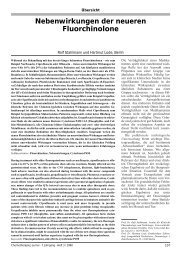
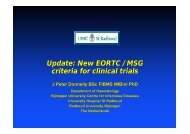
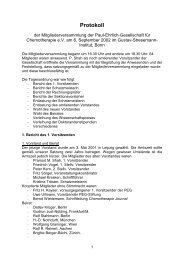
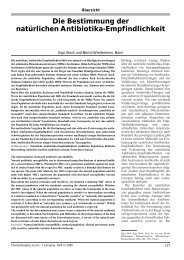

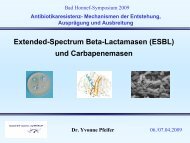
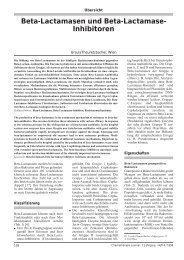
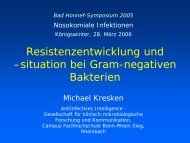

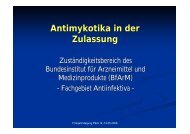
![Willinger.ppt [Schreibgeschützt]](https://img.yumpu.com/25098535/1/190x135/willingerppt-schreibgescha-1-4-tzt.jpg?quality=85)
